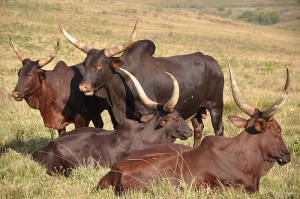
“Consider the cattle, grazing as they pass you by. They do not know what is meant by yesterday or today, they leap about, eat, rest, digest, leap about again, and so from morning till night and from day to day, fettered to the moment and its pleasure or displeasure, and thus neither melancholy nor bored. (…) Ever trusting in the divine provisions of nature and the reliability of human wisdom to sustain them…”
Nowhere in Nigeria does the above quotation from Untimely Meditations, by Friedrich Nietzsche, finds its truest expression than Mutum Biu Village, where local knowledge-driven technology meets with scientific adaptation measures, enveloping into an environmental splendour of sustainability and climate resilience.
Faced with adverse climate effects on rangelands, growing degradation of grazing lands with attendant soil erosion, loss of vegetation, changes in hydrology, and disrupted plant and animal communities, livestock grazers in Mutum Biu, a sleepy community on the Benue plains near Mambilla Plateau, in Taraba State, North-East Nigeria, decided to look within by tapping into native wisdom to create a local rotational grazing formula which significantly improved their sub-Saharan grassland production for grazing.
Speaking recently during a visit to the area by scientists from the Federal University, Kashere Nigeria and Lincoln University, New Zealand, the Head of Cattle Grazers Association who doubles as the Traditional Ruler of Mutum Biu, Ardo Guruza, gleefully revealed that they had to create the rotational grazing formula when “it dawned on us that grazing land on the Mambilla Plateau was fast depleting and desertification was setting in, necessitating the usual mobility southwards but with increasing agro-pastoralist crisis all over Nigeria, we had to look within ourselves to come up with this difficult but successful formula which demanded discipline and strict adherence from us.”
According to Chief Guruza, about three seasons ago, certain sections of the grazing land on the Mambilla Plateau were demarcated with local wires and all livestock grazers in Mutum Biu were sensitised on the need to graze their cattle in the non-demarcated areas. After a period of time, the locations were interchanged and the results were astonishing as their livestock grew in strength and number, eradicating decades of agro-pastoralist conflict as movement down southern Nigeria became unnecessary for Mutum Biu livestock farmers.
Adamu Fugo, a farmer in the community, corroborated the success story of the Mutum Biu rotational grazing formula. He said: “I am a farmer, and I have been doing rotational grazing for almost years years now. Rotational grazing did not only boost productivity of our land, but took the land to a whole new level of holistically managed and planned grazing. We are able to graze more livestock on the same land, we did not suffer drought even during dry season.”
Prof Bruce McKenzie, the Dean of the Faculty of Agriculture and Life Sciences at Lincoln University, and Prof Stephen Goldson, a research Theme Leader for the Bio-Protection Research Centre at the same university, who were part of the team that came to the Mambilla Plateau to provide expert advice on ways to further improve sub-Saharan grassland production for grazing through technology-driven methods, commended the community’s ingenious effort at adapting to climate change.
Prof McKenzie affirmed: “We did find some legumes growing throughout the Mambilla Plateau. This is encouraging in that it indicates that soil pH may be suitable for sowing other high value varieties. However, improving the plant species needs to be coupled with the reinforcement of the subsisting rotational grazing system.” “Going back to the era where cattle were left to indiscriminately graze, will undermine the grassland irrespective of plant types,” says Professor McKenzie. One cost-effective way of achieving this could be via the New Zealand-developed solar-powered electric fence technology; a suggestion that was met favourably by the local cattle grazers spoken with.
As climate change continues to cause additional stress to many West African rangelands including Nigeria, it therefore becomes necessary to promote and implement rotational grazing as the only viable grazing strategy with the capacity to arrest the decline and speed up the recovery of affected ecosystems while ensuring that the direct economic and social impacts are offset by a higher return on other ecosystem services and land uses.
According to a new report by eight researchers featured in Environmental Management, a professional journal published by Springer, “Climate impacts are compounded from heavy use by livestock and other grazing ungulates, which cause soil erosion, compaction, and dust generation; stream degradation; higher water temperatures and pollution; loss of habitat for fish, birds and amphibians; and desertification. Encroachment of woody shrubs at the expense of native grasses and other plants can occur in grazed areas, affecting pollinators, birds, small mammals and other native wildlife. Livestock grazing and trampling degrades soil fertility, stability and hydrology, and makes it vulnerable to wind erosion. This in turn adds sediments, nutrients and pathogens to western streams.”
The report further affirmed that grazing and trampling reduces the capacity of soils to sequester carbon, and through various processes contributes to greenhouse warming. Rotating or significantly reducing grazing is likely to be far more effective, in cost and success, than piecemeal approaches to address some of these concerns in isolation.
As desertification increasingly becomes a fancy word for land that is turning to desert, fanning the embers of agro-pastoralist conflicts across Nigeria, and climate change continues to affect public land ecosystems and services throughout Africa with these effects projected to intensify even if greenhouse gas emissions are reduced, adaptation strategies such as the homegrown, local but nonetheless effective rotational grazing system in Mutum Biu and the New Zealand-developed solar-powered electric fence rotational technology are needed to ensure that the fruitful, green fields of Africa are trod by both man and animal in a manner that secures a sustainable future for all!
By Atayi Babs (atayibabs@yahoo.com)
